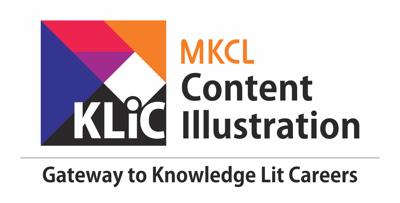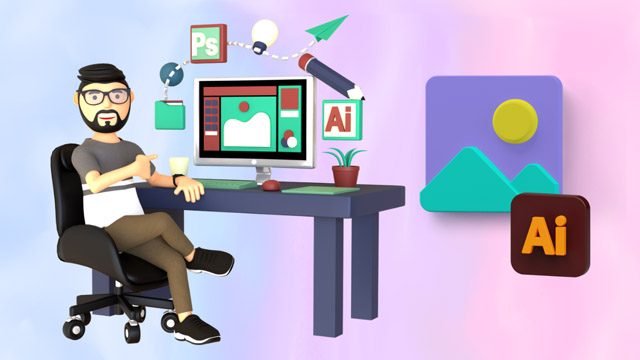- In this course, you will learn to:
- Classify different illustration styles based on their visual characteristics and applications
- Define the historical evolution of illustration from traditional to digital mediums
- Identify various digital illustration tools and their functionalities
- Organize vector design elements to create balanced and visually appealing compositions
- Reorganize digital files and assets using industry-standard organizational practices
- Summarize career opportunities available in illustration, including animation and design
- Compare vector and raster graphics in terms of their characteristics and applications
- Report on the process of logo design, including the use of basic tools and techniques
- Classify different types of brushes and their applications in digital illustration
- Diagnose common issues in vector design and troubleshoot using appropriate tools
- Operate the Pen Tool efficiently to create precise and intricate illustrations
- Find solutions to design challenges using advanced vector design techniques
- Predict the outcome of different shading techniques on the appearance of an illustration
- Compare different typography effects and their impact on visual communication
- Define the principles of visual storytelling and illustrate their application in narrative illustrations
- Identify various techniques for character development in sequential storytelling
- Organize sequential storyboards effectively to convey narrative flow and progression
- Summarize the ethical considerations and representation standards in visual storytelling
- Compare different methods for crafting mood and atmosphere in narrative illustrations
- Report on the process of creating art from thumbnails and rough sketches, including concept refinement
- Diagnose various layer management techniques in vector design
- Operate advanced layer options for efficient vector illustration workflow
- Find the impact of color theory on storytelling and illustration mood
- Compare different watercolor painting techniques for creating unique effects
- Categorize the effectiveness of specialized tools and techniques in vector design
- Differentiate between different perspective grid tools and apply them in object drawing
- Explain the process of creating graphs and sliced text effects using slicing and cutting tools
- Predict the impact of advanced keyboard shortcuts on vector design productivity
- Identify the key features and functionalities of digital illustration software
- Organize digital brushes according to their types and applications
- Summarize effective layer management strategies for organizing artwork in digital illustration software
- Compare different methods for creating custom palettes and color swatches to optimize workflow efficiency
- Define advanced color theory concepts and explain their significance in design
- Classify global colors and color groups and demonstrate their application in artwork creation
- Differentiate between various color harmonies and schemes using the Color Guide panel
- Examine the process of adjusting color schemes and harmonies using Recolor Artwork and Live Color features
- Operate advanced blend modes such as Overlay, Color Dodge, and Soft Light to create unique color effects
- Predict the outcomes of applying gradient mesh techniques for shading and highlighting in digital illustrations
- Report on the importance of Pantone Spot Colors and effective color management for consistent reproduction
- Arrange workspace palettes and utilize object manipulation tools effectively for graphic design in Adobe Illustrator
- Classify different types of symbols and demonstrate their application in graphic design projects
- Explain the process of creating custom palettes and color swatches for high-impact magazine design

Digital Illustration Pro
Create detailed digital illustrations using advanced tools and design techniques.
Introduction
What you'll learn ?
- At the end of this course, learners will be able to:
- Interpret various illustration styles and their applications across different industries
- Illustrate the significance of visual communication skills in conveying complex ideas through illustrations
- Paraphrase historical perspectives on illustration evolution from traditional to digital mediums
- Estimate the impact of different illustration techniques on branding strategies
- Defend the relevance of illustration in modern storytelling and advertising campaigns
- Compare and contrast digital illustration software and traditional drawing techniques
- Review the historical contributions of iconic illustrators to the evolution of the craft
- Rewrite traditional drawing exercises to incorporate contemporary digital tools and techniques
- Construct a personalized illustration portfolio showcasing diverse styles and techniques
- Estimate the career prospects in animation, illustration, and design fields
- Appraise the effectiveness of color techniques in conveying mood and emotion in illustrations
- Combine vector design basics with advanced illustration techniques to create professional-grade artwork
- Solve complex illustration challenges using advanced tools such as the Pen Tool and Mesh Tool
- Interpret principles of visual storytelling to analyze and critique narrative illustrations effectively
- Illustrate sequential stories in comics, applying learned techniques in character development and scene composition
- Paraphrase ethical considerations in storytelling, demonstrating an understanding of representation and cultural sensitivity
- Estimate the impact of mood and atmosphere in narrative illustrations through case studies and practical exercises
- Defend chosen illustration styles by comparing and contrasting with established artistic approaches
- Compare layer management techniques to optimize workflow efficiency in vector design projects
- Review advanced techniques in pen and ink illustration, identifying best practices for cross-hatching and stippling
- Construct seamless patterns using vector design tools, applying knowledge of color theory and psychology
- Estimate market demand for stock images, proposing strategies to monetize illustrations on popular platforms
- Appraise the effectiveness of color harmonies in conveying mood and atmosphere in illustration projects
- Combine vector design elements to create cohesive eBook cover designs, applying principles of balance and composition
- Solve design challenges using perspective grid tools, demonstrating proficiency in one, two, and three-point perspective
- Predict user engagement with vector design projects through analysis of graphical data using graph tools and techniques
- Interpret the basic functions and interfaces of digital illustration software
- Illustrate proficiency in navigating and utilizing various digital brushes and techniques for diverse artistic applications
- Paraphrase advanced color theory concepts and articulate their significance in design practice
- Estimate the impact of different blend modes on color effects and apply them creatively to enhance illustrations
- Defend the importance of global colors and color groups in maintaining design consistency and efficiency
- Compare various color harmonies and schemes using the Color Guide panel to inform artistic decisions
- Review techniques for adjusting color schemes and harmonies in complex illustrations using Recolor Artwork and Live Color features
- Rewrite type attributes using advanced typography tools such as Character and Paragraph palettes
- Construct symbol libraries for efficient workflow and consistent design language.
- Estimate the effectiveness of graphic styles and effects in enhancing the visual impact of designs
- Appraise workspace organization techniques and palettes arrangement for streamlined design workflows
- Combine automated processes like actions and scripts with manual design approaches for efficient design production
- Solve design challenges through the application of advanced techniques like gradient mapping and transparency
- Predict emerging trends in digital illustration tools and techniques based on knowledge of recent updates
Certification
- KLiC courses are recognised by Yashwantrao Chavan Maharashtra Open University (YCMOU).
- MKCL provides certificate to the KLiC learner after his/her successful course completion.
- Yashwantrao Chavan Maharashtra Open University (YCMOU) provides mark sheet to successfully passed KLiC learners (Jurisdiction: Maharashtra).
Academic Approach
The academic approach of the courses focuses on the “work-centric” education i.e. begin with work (and not from a book!), derive knowledge from work and apply that knowledge to make the work more wholesome, useful and delightful. The ultimate objective is to empower the Learner to engage in socially useful and productive work. It aims at leading the learner to his/her rewarding career as an employee or entrepreneur as well as development of the community to which s/he belongs. Learning methodology:
- Step -1: Learners are given an overview of the course and its connection to life and work.
- Step -2: Learners are exposed to the specific tool(s) used in the course through the various real-life applications of the tool(s).
- Step -3: Learners are acquainted with the careers and the hierarchy of roles they can perform at workplaces after attaining increasing levels of mastery over the tool(s).
- Step -4: Learners are acquainted with the architecture of the tool or tool map so as to appreciate various parts of the tool, their functions, utility and inter-relations.
- Step -5: Learners are exposed to simple application development methodology by using the tool at the beginner’s level.
- Step -6: Learners perform the differential skills related to the use of the tool to improve the given ready-made industry-standard outputs.
- Step -7: Learners are engaged in appreciation of real-life case studies developed by the experts.
- Step -8: Learners are encouraged to proceed from appreciation to imitation of the experts.
- Step -9: After the imitation experience, they are required to improve the expert’s outputs so that they proceed from mere imitation to emulation.
- Step-10: Emulation is taken a level further from working with differential skills towards the visualization and creation of a complete output according to the requirements provided. (Long Assignments)
- Step-11: Understanding the requirements, communicating one’s own thoughts and presenting are important skills required in facing an interview for securing a work order/job. For instilling these skills, learners are presented with various subject-specific technical as well as HR-oriented questions and encouraged to answer them.
- Step-12: Finally, they develop the integral skills involving optimal methods and best practices to produce useful outputs right from scratch, publish them in their ePortfolio and thereby proceed from emulation to self-expression, from self-expression to self-confidence and from self-confidence to self-reliance and self-esteem!
Syllabus
Evaluation Pattern
Evaluation Pattern of KLiC Courses consists of 4 Sections as per below table:
| Section No. | Section Name | Total Marks | Minimum Passing Marks |
|---|---|---|---|
| 1 | Learning Progression | 25 | 10 |
| 2 | Internal Assessment | 25 | 10 |
| 3 | Final Online Examination | 50 | 20 |
| Total | 100 | 40 | |
| 4 | SUPWs (Socially Useful and Productive Work in form of Assignments) | 5 Assignments | 2 Assignments to be Completed & Uploaded |
YCMOU Mark Sheet
Printed Mark Sheet will be issued by YCMOU on successful completion of Section 1, Section 2 and Section 3 and will be delivered to the learner by MKCL.
YCMOU Mark Sheet will be available only for Maharashtra jurisdiction learners
MKCL's KLiC Certificate
The certificate will be provided to the learner who will satisfy the below criteria:
- Learners who have successfully completed above mentioned 3 Sections i.e. Section 1, Section 2 and Section 3
- Additionally, learner should have completed Section 4 (i.e. Section 4 will comprise of SUPWs i.e. Socially Useful and Productive Work in form of Assignments)
- Learner has to complete and upload minimum 2 out of 5 Assignments
Courses Fee Structure from 01 July, 2025 Onwards
KLiC 90 hour course fee applicable from 01 July, 2025 all over Maharashtra
| KLiC Course Duration | MFO (Inclusive of GST) |
ALC Share (Service Charges to be collected by ALC) |
|---|---|---|
| 90 hours | Rs. 750/- | Rs. 4,000/- |
* Above mentioned fee is applicable for all Modes of KLiC Courses offered at Authorised Learning Center (ALC) and at Satellite Center
* Total fee is including of Course fees, Examination fees and Certification fees
* MKCL reserves the right to modify the Fee anytime without any prior notice
